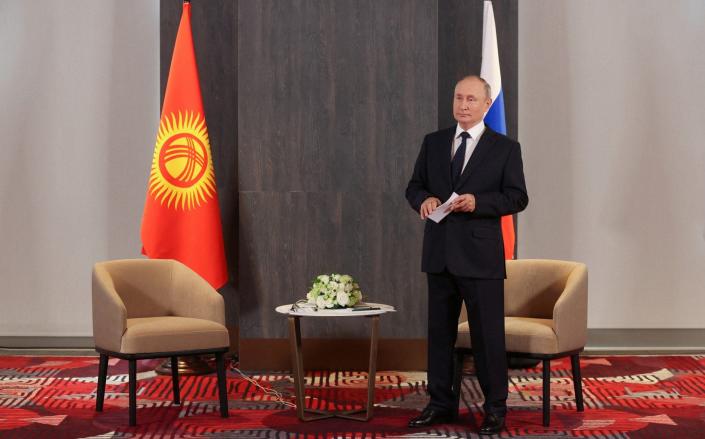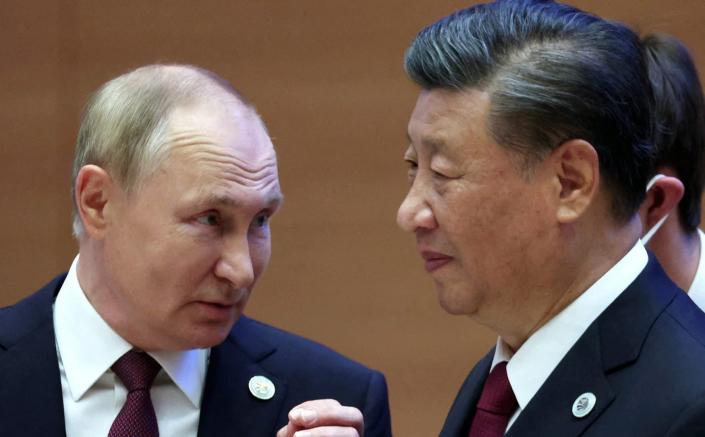
Vladimir Putin infamously kept Queen Elizabeth II waiting for 14 minutes during a state visit in 2003. Officials at the Palace were already nervous. The Russian President was notoriously tardy, in future years showing up late to meetings with former US Presidents Donald Trump, Barack Obama and even keeping the Pope waiting for almost an hour.
Some believed he wouldn’t dare do that to a monarch. But when the delay materialised, then home secretary David Blunkett – and his guide dog – were audibly annoyed.
“My then dog barked very loudly,” Blunkett recalled in an interview this year. When he apologised to his host, the late Queen’s decision to break Royal protocol with a six-word reply captured the mood: “Dogs have interesting instincts, don’t they?”
How the tables have turned. The man who often left his ex-wife waiting for hours when they started dating was himself standing alone on Thursday. The offender was no monarch or Holy See, but the President of Kyrgyzstan. Sadyr Japarov, the leader of the world’s 142nd biggest economy, isn’t exactly a household name.
The moment was captured on camera, Putin awkwardly shuffling his cue cards around as he stood waiting for Japarov to eventually saunter into shot. If there was any doubt over Putin’s place in the current world order, this excruciating 45 seconds proved that the Russian bear is wounded.


Another sign of the shifting balance of power in the region was Putin’s carefully-worded statement ahead of his meeting with Xi Jinping, China’s premier.
The meeting itself was Xi Jinping’s first foray outside China since the pandemic hit. It was billed as a gathering of Asia’s strongmen. But talks in the ancient Silk Road desert city of Samarkand in Uzbekistan left no doubt as to who was the junior partner in this relationship.
Putin said he acknowledged Chinese “concerns” about the Kremlin’s war in Ukraine. It was the first significant admission of differences between Beijing and Moscow over the conflict. While he praised Beijing’s “balanced position”, Putin said he would explain himself on the sidelines of the meeting.
By contrast, Xi did not mention Ukraine at all in his remarks, stating instead that China was “willing to work with Russia to demonstrate the responsibility of big powers” and ironically to “instill stability and positive energy in a world of chaos”.
Even India, which has shied away from explicitly condemning Russia for the invasion, spoke out. Narendra Modi, India’s prime minister, told Putin that “today’s time is not a time for war,” and stressed the importance of “democracy and diplomacy and dialogue”. His comments drew a response from the Russian leader, who said the Kremlin would “do our best to end this as soon as possible”.
As the tectonic plates shift, and Putin suffers setbacks on the battlefield, the Russian leader’s waning influence is clearer than ever. And observers are left wondering: Who will rescue the Russian president from this self-inflicted disaster? Will China, long a junior partner in the relationship with Moscow, seize this moment to make its neighbour into a vassal state?
‘Axis of convenience’
Analysts said Putin’s acknowledgement of frictions between the countries was telling.
“I think what we saw was pretty clear evidence of where the balance of power within the Eurasian landmass itself has shifted,” says Maximilian Hess, a fellow at the Foreign Policy Research (FPR) Institute.
“Putin acknowledging Xi’s concerns, which he didn’t even directly vocalise himself, is certainly a very clear sign that there are differences in opinion of how to approach Ukraine and Russia’s approach to it.”
Alexander Gabuev, a senior fellow at the Carnegie Endowment for International Peace in Washington DC, agrees that the relationship between Russia and China is far from equal.
“Russia is reorienting itself to China. But their relationship now is deeply asymmetric. China is clearly the stronger partner.
“That said, the Chinese are skillfully massaging Russia’s ego with their rhetoric. And their broader attitudes toward each other helps. China doesn’t care about Alexei Navalny [the Putin critic who has been poisoned and thrown in prison by the Kremlin], and Russia doesn’t care about Xinjiang. That provides a type of glue for their relationship that makes it more comfortable for them to talk.”
Easy or not, Putin has a reason to be humble. The man who has vowed to only deal with “friendly” nations is quickly losing them.
Moscow has also suffered setbacks in Ukraine amid a lack of manpower and supply challenges. Several stories suggest momentum is shifting towards Ukrainian counterattacks.


Despite the bloody backdrop, Russia remains determined to challenge the world order, a goal that it shares with its Chinese counterpart.
A statement issued by Moscow and Beijing during this year’s Winter Olympics stated their friendship was one with “no limits” or “forbidden” areas of cooperation. But despite the warm words, it is a relationship that foreign policy expert and independent analyst Bobo Lo describes as an “axis of convenience”.
It is worth remembering that relations between China and Russia have not always been cordial. For almost a quarter of a century, the two nations were Cold war adversaries, with the relationship characterised by bitter quarrelling from the 1960s over borders and invasions of Afghanistan and Vietnam.
But whether or not their relationship is based on convenience or ideology, both see opportunities for more trade, mutual de-dollarisation and an opportunity to win new customers.
After all, China needs fuel to fire up its factories, Russia needs cash and technology to build its economy. And both need friends. But can Putin’s eastern pivot save the Kremlin from disaster?
For Russia, where oil and gas revenues account for more than a third of the nation’s budget, finding a new home for the millions of barrels of oil that the EU and other countries plan to shun is a priority.
Soaring prices helped Russia earn $1bn (£880m) a day in the first 100 days of the war.
Analysts at Barclays say high gas prices have also helped to prop up Gazprom. It “conservatively” estimates that at $70bn, the state-backed energy firm has already generated more revenue this year than in the whole of 2021, which was already the most profitable for the group in recent years.
But sanctions have squeezed revenue streams, and sources for cash are narrowing by the day.
Russian oil, going cheap
Russia used to supply around a third of the European Union’s oil imports and 40pc of its gas. While oil imports have fallen more slowly, the bloc’s share of gas from Russia has dropped from around 40pc before the war to around 20pc today, partly due to Russia cutting off supplies.
But signs of a looming cash crunch are already evident. Europe’s pivot away from Moscow has forced it to sell oil at a steep discount in Asian markets in some cases, depriving it of the full benefit of higher prices.
Oil and gas revenues fell 13pc to $11.1bn last month, the lowest since June 2021. The EU currently imports around 3 million barrels of oil per day from Russia, but the bloc’s plan to stop using Moscow’s crude from December and all oil products from next February will have a bigger impact on Russian revenues.
Other countries are following suit. IEA data show that the US, South Korea and Japan, which were on average importing a million barrels of oil a day before the war, have reduced purchases to almost zero today. That leaves around four million barrels of oil every day without a home.
China, India and Turkey have already picked up some of the slack. The three countries have increased Russian imports from around 2 million barrels of oil per day before the war to more than 3 million barrels in the last few months.
However, Gabuev says there are limits to how much oil China can purchase from Moscow. As analysts at Morgan Stanley highlight, Russia is already the largest crude oil supplier to China, accounting for around a fifth of imports over the past two months.
Analysts say this is far above historical averages. They note that even Saudi Arabia has not supplied more than 20pc of China’s imports over a 12-month period in the last decade. There’s only so much black gold even China can burn.
Other options include increasing supply to countries in Africa, which imports 4 million barrels per day; South America, which imports 1.5 million barrels; and other Asian nations, which need 7 million barrels – though with South Korea and Japan already shunning Russian crude, the last option looks unlikely.
Courting more market share could also spark diplomatic tensions. “All those countries have existing suppliers, from which Russia would need to take market share,” Morgan Stanley analysts said in a note.
Tiptoe through the red lines
Russia is also looking east to build the Power of Siberia 2 pipeline, which is expected to run through Mongolia from western Russia and will power China’s energy-hungry economy.
Once built, around 50bn cubic meters of natural gas will run through the pipeline per year, representing a third of what Russia used to sell to Europe. Russian Energy Minister Alexander Novak claims this will replace the Nord Stream 2 pipeline that was planned to run to Germany.
The eastern gas pipelines have been in the works since 2006, with Power of Siberia 1 now up and running and China agreeing to a 30-year deal to import natural gas. Its successor is expected to begin building works in 2024.
“There’s no other big market apart from China that Russia can sell its gas to,” says Gabuev.
“So building a pipeline there is the easiest way forward. He adds that the project provides a win-win solution for both countries.
“It’s going to be the cheapest gas that China gets from anywhere. Any concern that Mongolia is an unreliable partner in the project has also gone.”
While flows of gas through the Nord Stream 1 pipeline are unlikely to resume any time soon, Barclays believes that a full cut-off from Europe is unlikely. It believes the Turkstream pipeline, which runs under the Black Sea and delivers gas to Turkey, Serbia and Hungary, can keep Gazprom profitable if gas prices remain high.
Trade ties between Russia and China are also growing. Goods traded between the two countries surged 31pc to $117.2bn in the first eight months of 2022, according to Chinese customs data. That’s already 80pc of last year’s record total.
Meanwhile, Chinese spending on Russian goods soared 60pc in August compared with a year ago, while its shipments to Russia jumped 26pc to $8bn in August.
But Russia remains a small part of China’s trade, at just 2.8pc of its total trade volume. That figure is dwarfed by the EU and US.
William Jackson, chief emerging markets economist at Capital Economics, says the importance of two of the largest trading blocs in the world means China will remain cautious when it comes to trading with Moscow.
“China is a vastly larger economy, it’s more integrated in the global economy. It’s really Russia that’s more dependent on China than the other way around,” he says.
“Chinese officials are worried about sanctions on Russia and the risks that secondary sanctions could be introduced that could affect them. They’re not going to help Russia out at the expense of their own broader interests.
“For Beijing, the West is a much bigger market than Russia. It would be a big risk to face that threat of sanctions from the West just for the sake of continuing to do business with them.”
Gabuev says the relationship between China, Russia and the US is more nuanced.
“China understands that it mustn’t cross American red lines,” he says.
“But the real question for them is: if we throw Vladimir Putin under a bus, does it fundamentally change our relationship with the US? Or will Washington just pocket that win and keep up its pressure on Taiwan, Xinjiang, and intellectual property theft?
“In short, dumping Russia will not result in any real improvement in relations with the US, so why would they do it? I think Beijing will be careful not to cross any red lines, but otherwise it is going to be happy exploring opportunities.”
Putin’s middleman


One country that Hess at the FPR believes the world must keep an eye on is Turkey.
He says Ankara is providing Russia with one of the “biggest loopholes for the current sanctions regime”.
Since the start of the war, Moscow has found ways to import sanctioned goods via nations that haven’t cut ties with the Kremlin – and Turkey is one of them.
It has become a destination for billions of pounds more in imports from countries that aren’t supposed to be trading with Vladimir Putin’s regime.
Gabuev notes that Turkey’s exports to Russia have grown by 50pc since the start of the war. It’s also quickly becoming a middleman for luxury goods.
Pre-orders for the new iPhone have more than doubled since last year, notes Gabuev, even though Apple pulled out of the country at the start of the war.
“The price has gone up significantly though,” he notes from conversations with Russian friends. “To use the Russian term, there’s been an increase in ‘parallel imports’.”
“In English that’s called “smuggling”. Many people pre-order the phones to go to Turkey. But everyone knows the real destination is Russia.”
Both Hess and Gabuev believe Washington will need to engage in a charm offensive with Turkey’s president Recep Tayyip Erdoğan to cut off this channel. But they must tread carefully.
“Turkey has a lot of leverage at the moment over Sweden and Finland’s accession to Nato. It also helped to broker a grain deal between Russia and Ukraine,” says Gabuev.


‘Russia is going to become like Iran’
“McDonald’s has a different name, but it tastes exactly the same,” says one analyst still based in Russia. The golden arches may have been dismantled, but they’ve been replaced with a new firm: “Vkusno-i tochka” which broadly translates as “Delicious – that’s all”, in Russian.
Lots of people have already fled, including Gabuev. He says friends who are still there say life is “more or less normal at the moment. Prices are up a little bit. Many Western brands have left.
“But people can still go to shops in Istanbul for Zara and H&M. For the middle class nothing has changed really.”
While Russia has stopped publishing all but the most selective statistics, Jackson at Capital Economics says the economy today is also in better shape than some might have predicted. “Russia has been drawing down its savings,” he says.
“They’ve returned to the domestic bond market and they’ve been helped in this regard by the fact that the rouble has strengthened, which means inflation has really come down a long way.”
That allowed the central bank to lower interest rates this week to 7.5pc.
“That means borrowing costs for the government are lower than they were a few months ago,” Jackson adds.
“At the same time we’ve seen a surge in energy prices. Russia’s been in quite a strong position. So even though it has defaulted on its foreign bonds, there’s little to worry about on the fiscal side at the moment.”
Capital Economics also highlights that Russia didn’t often issue debt on international markets anyway. The outstanding value of its foreign exchange bonds amounted to $37bn, which it says is comparable to Chile and the Philippines.
Looking ahead, Goldman Sachs notes that Russia is also increasingly issuing debt in Chinese yuan. Liquidity in the yuan market recently overtook that of the dollar market, while some companies, including aluminium giant Rusal and Polyus, Russia’s largest gold miner, are already issuing yuan-denominated debt.
“This is likely to be followed by the sovereign”, Goldman said in a note.
But Gabuev says pain is coming, as are fundamental changes to Russia’s economy.
“Sanctions will take time. The real pain is a year from now when the EU shuns Russian energy and a price cap takes effect. We are currently in month eight.
“A shortage of parts due to sanctions is also expected to hit the economy more. Russia currently makes cars without basic safety features like airbags and anti-lock braking systems in order to keep local production going.
“You’ll have to be a Formula 1 driver just to go to the shops,” says one Russian analyst.
Gabuev says these problems will mount up.
“Russia is behind on making cutting-edge semiconductors by between ten and 15 years, according to some reports, but I think that’s optimistic. The lag could be more like 30 years. So either they smuggle them in or wait until China catches up with the technology. Either way, it will take years.”
So what does that mean for consumers and the wider economy? “Russia is going to become like Iran,” says Gabuev.
“Think about what technology was like in the 1990s, when cars and electronics were made before the era of modern chips. We’re going to see more patchwork solutions. Maybe we’ll see more Walkmans,” he jokes.
For Hess, the endgame is near. “Russia is going from an autocratic market economy to an autarky with the trappings of a market economy, but it isn’t one at all because the state will continue to dominate,” he says.
“It’s going to look more like North Korea or Turkmenistan, even though Russia is larger and has more commodities. I think the real economic indicator is household disposable income. That’s taken a big hit since Putin’s annexation of Crimea in 2014 and I don’t think it will ever recover while Putin is in charge.”
In future, the Russian president may find he spends a lot more time waiting for others to come to his aid.




